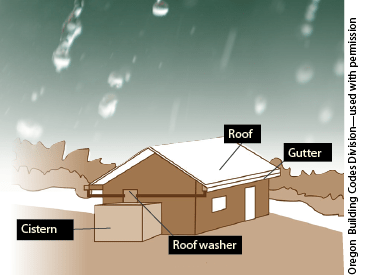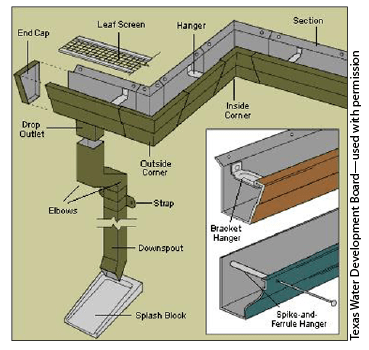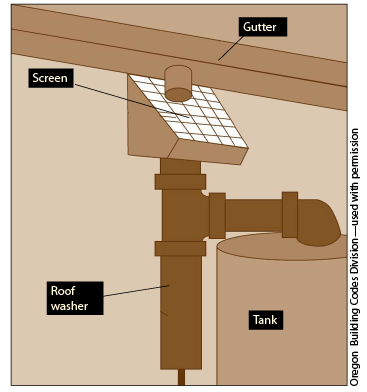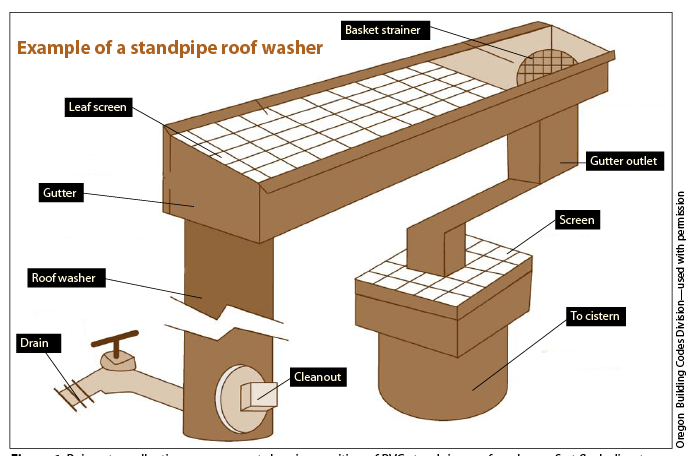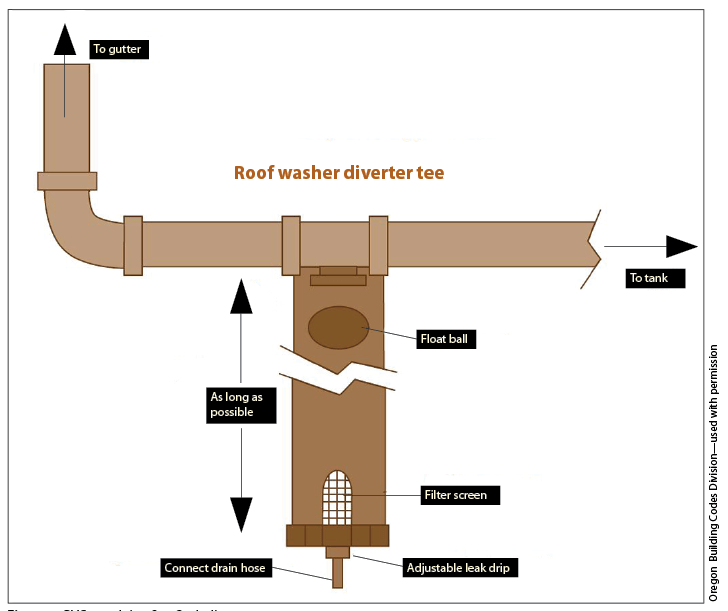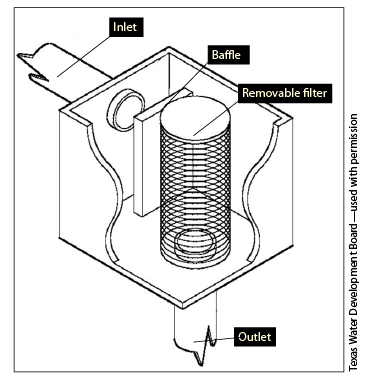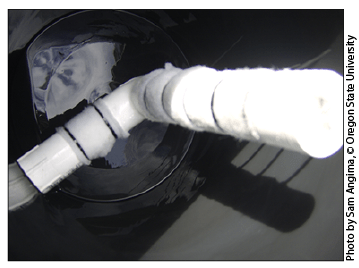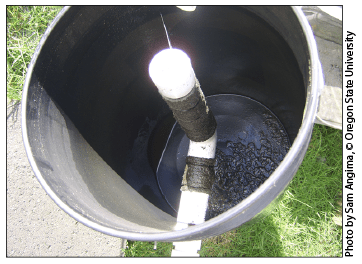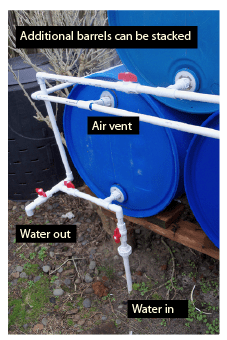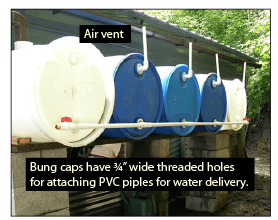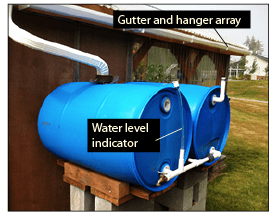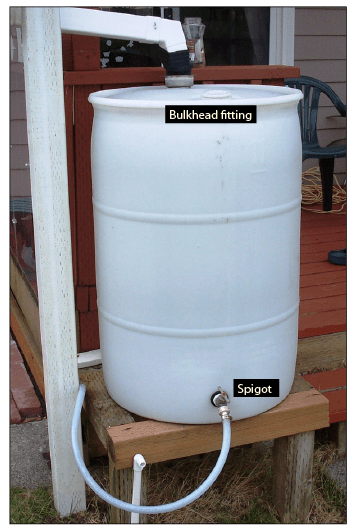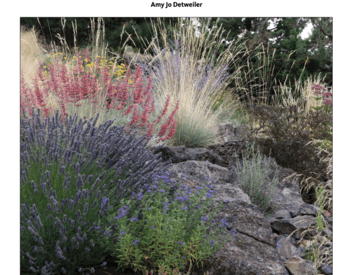Rainwater harvesting is the capture, diversion, and storage of rainwater for a number of different purposes. Although water is publicly owned in Oregon, state law allows residents to collect runoff from rooftops and store it in reservoirs, rain barrels, water tanks, or other containers. For those with small acreage property (ideally, less than 1 acre), harvested and stored rainwater can cut city and well-water consumption by providing an alternative source for irrigating landscapes, vegetables, or small fruit gardens.
Other than the initial cost of installing a catchment and pumping-and-delivery system, rainwater is free. Rainwater also tends to be pure, soft (fewer salts than city or well water), and near neutral pH (not acidic or basic). Capturing, storing, and using rainwater also helps reduce the intensity and flow of storm waters. If used to irrigate, rainwater helps flush salts off lawn and garden soils while reducing overall water bills.
Water Collection
The easiest and most common way for homeowners to harvest rainwater is through a rainwater collection system that includes a roof, gutters or roof drains, and a piping system to convey the water to and from a storage system. Designs range from a simple rain barrel at the bottom of a downspout for watering a garden to extensive cistern systems that can provide substantial amounts of water for large-scale and long-term uses. New filtration and treatment technologies make rainwater relatively safe to use. Rainwater harvesting systems can be installed in existing buildings or incorporated into new construction. Storage tanks can be inside or outside, above or below ground, or partially above and partially below ground (Figures 1 and 2).
Catchment Area
If you are collecting rainwater from your house, the catchment area is the roof surface. All types of roofs can be used to collect water for gardening purposes. Asphalt shingles and metal are common roofing materials in Oregon. Metal roofs harbor fewer contaminants, but asphalt shingles are OK if the water collected from it is used for gardening. In eastern Oregon, where rainfall is less than in the west, metal roofs maximize the amount of water that can be harvested; other roof types have to saturate with water before releasing it for collection.
The slope of the roof also affects how quickly water flows down the roof to the gutter system. A steep roof will enhance quick runoff and also easily clean the roof of environmental contaminants. These contaminants easily get cleaned out by the first flush diverter system (Figures 5 and 6), ensuring that the rainwater collected is much cleaner. A less-steep, flatter roof (or a roof with lots of moss) will cause the water to percolate or move more slowly, increasing the chances that finer contaminants from the roof composition will not get cleaned by the first flush diverter system and will increase their concentration in the rainwater storage tank.
Sizing a Catchment Area
The size of the catchment area or roof will determine how much rainwater you can harvest. The area is based on the “footprint” of the roof, which can be calculated by finding the area of the building and adding the area of the roof’s overhang. Figure 3 shows how differences in roof slope, shape, or configuration, alone, do not change the catchment area.
Components of a Rainwater Harvesting System
A full rainwater system will need investments in the following areas:
- Catchment surface (usually a roof)
- Gutters and downspouts
- Leaf screens
- First flush diverter and primary filtration to remove debris and contaminants before going to storage tank
- Storage tanks (or cisterns)
- Delivery system (gravity fed or pumped)
- Treatment or purification—optional
1. Catchment Surface
Before investing in a collection system, determine how much water you need, especially during the three dry summer months in Oregon. Use local rainfall data to determine if you can collect enough water to meet your needs, given the size of your catchment area and garden size. (See “How Big an Area Can You Irrigate?”)
2. Gutters and Downspouts
Gutters and downspouts (Figure 4) convey the water to the storage tanks. When selecting gutters and downspouts, it’s important to consider three factors: sizing, proper installation, and aesthetics. If building a new roof, the gutters should be sized so that they adequately move rainwater runoff from a 100-year storm event. However, standard gutters do an adequate job in western Oregon because the area gets less-intense storms despite the high rainfall totals. As a general rule, gutters should be at least 5 inches wide. For downspouts, provide 1 square inch of downspout area for every 100 square feet of roof area (e.g., a 3-inch x 4-inch downspout is 2 square inches, and can accommodate runoff from a 1,200-square-foot roof). If possible, install rounded-bottom gutters as they limit debris buildup over time. Install them so that the slope is 1/16-inch per foot of length for proper drainage.
Varying sizes of leaf screens can be used on downspouts in rainwater collection systems. However, these leaf screens are prone to clogging, especially if not checked and cleaned regularly. Install gutter hangers (Figure 4 and Figure 10d), every 3 feet to bear the added weight from debris buildup and clogs.
3. Leaf Screens
It is imperative to install leaf screens(Figure 4) at each downspout being used for rainwater catchment. These screens remove debris that gathers on the catchment surface. This ensures that filters won’t easily clog, and it results in higher-quality water that can go through pumping systems and not clog irrigation systems. Leaf screens must be regularly cleaned to be effective. If not maintained, leaf screens can become clogged and prevent rainwater from flowing into a tank. Built-up debris can also harbor contaminants and disease-causing bacteria. Mesh screens are usually 1/4-inch-square wire frames that fit along the length of the gutter. If a building is surrounded by many trees, consider using leaf guards to allow leaf litter to slide off the gutter system.
4. First Flush Diverters
First flush diverters, sometimes called roof washers (Figures 5 and 6), are a “must-have” for any rain collection system. The first flush diverter routes the first flow of water from the downspout away from the storage tank. While leaf screens remove the larger debris (e.g., leaves, twigs, and blooms), the first flush diverter gives the system a chance to rid itself of the smaller contaminants, such as dust, pollen, and bird and rodent feces. Periodic cleaning and maintenance of the first flush system is essential to ensuring a worry-free collection system.
There are many types of first flush systems, but the simplest is the PVC standpipe (Figure 7). The standpipe fills with water first during a rainfall event, and the balance of water is routed to the tank. The standpipe is drained continuously via a pinhole, by leaving the screw closure slightly loose, or by an adjustable leak drip/filter screen system to allow continuous draining that simultaneously traps incoming fine debris (Figure 7). Clean the standpipe by lifting off the PVC screw-cup cover and removing collected debris at least once a month during rainfall seasons. One rule of thumb for first-flush diversion is to divert a minimum of 10 gallons for every 1,000 square feet of collection surface for every 1 inch of rainfall. However, first-flush volumes vary with the amount of dust on the roof surface, which is a function of the number of dry days, the amount and type of debris, the extent of tree overhang, and the season. In winter and spring, when there is continuous rainfall, first diverters can be cleaned less frequently.
5. Filter System
After the water leaves the first flush diverter, it can be channeled to the storage tank and used later for gardening purposes. However, if this water will be used for drip irrigation, a filter system should be used. The filter system can either be positioned before the storage tank or after the storage tank and before the pump. Using a filter system that can easily and quickly be cleaned periodically before the storage tank is much more convenient than trying to clean the storage tank after it accumulates sludge from dust and fine debris that is not captured by the first flush diverter. Filter systems, called roof washers, consist of a 30- to 50-gallon tank equipped with a 30-micron filter (Figure 8) whose pores are about one-third the diameter of a human hair. These filters are located adjacent to the storage tank for ease of cleaning. Homemade filters, consisting of air and dust vent filter material lined up and secured to a perforated PVC pipe, have been successfully used in household rainwater collection systems. These are easily cleaned weekly using a jet of high-pressure water to remove accumulated sludge (Figure 9a and 9b).
6. Storage Tanks (Cisterns)
Storage tanks or cisterns store rainwater for use during dry periods. They are also the most expensive component of a rainwater collection system. The tank size is dictated by the rainfall amount in your area, your budget, the demand for water during dry periods, the catchment surface area, aesthetics, and personal preference.
There are many storage solutions out there. We recommend that storage tanks:
- should not have previously been used to store toxic materials
- be opaque to sunlight to inhibit algae growth
- be covered and have vents screened to discourage infestation by insects and frogs
- be accessible for cleaning and/or repair
- be close to the irrigation site
- have an inlet that is lower than the lowest downspout exit point
- be placed as high as practicable to reduce load on pump (if using pumps)
- have an overflow outlet directed away from the house foundation or septic drainfields
- be placed on a stable foundation, as water is heavy at 8 pounds per gallon (a full 3,000-gallon tank will weigh over 24,000 pounds)
The most easily available and affordable storage tank solutions for homeowners are 50- or 75-gallon, food-grade barrels. These can be connected in a variety of ways to store and deliver water for use (Figure 10a, 10b, 10c, and 10d). Some commercially available rain barrels are manufactured with overflow ports linking the primary barrel to a second barrel (Figure 10a).
In others, a screen trap at the water entry point discourages mosquito breeding. A food-grade plastic barrel used for bulk liquid storage in restaurants and grocery stores can be fitted with a bulkhead fitting and spigot for garden watering (Figure 11). Other storage tank types include fiberglass, polypropylene tanks (available in capacities from 50 gallons to 10,000 gallons—Figure 12), galvanized sheet metal, and concrete.
How large a storage tank do you need for your gardening use? One size will not fit all uses or needs! Each homeowner has different gardening preferences, and different crops need watering at different times and in different amounts. However, you can use some guidelines to help you decide what will work best for you.
Consider that in hot summer months, gardeners on average water their gardens at a depth of about 2 inches per week depending on soil type, tilth or drainage, relative humidity, and temperature. Since sprinkler irrigation systems are at best 75 percent efficient at delivering water to the soil, the 2 inches per week translate to 2.66 inches of water applied each week of summer, if watering is done by sprinklers. From the rainwater collection formula discussed earlier, about 0.62 gallons of water is equal to 1 inch of water (or rain) applied to 1 square foot of garden space. Therefore, for a garden space or raised bed of 10 x 3 feet (30 square feet), you would need about 49.5 gallons of water per week (see “Sprinkler and Irrigation Calculation”). Multiply this by the three months (90 days/7 days = 12.85 weeks) when there is no adequate rainfall in summer. By this calculation, a gardener will need at least 620 gallons of stored rainwater to irrigate the 30-square-foot garden, assuming a very dry summer and no recharging of the soil or the tanks by rain. Even if it is not possible to use only rainwater for summer garden irrigation, getting a tank that is nearly double the size of your watering needs will save you a portion of the city or well water used during peak summer periods for gardening purposes. Use of drip or soaker irrigation can increase efficiencies to 85 percent to 90 percent . Adding organic matter over time can allow your soil to hold more water in the summer, thus requiring less irrigation water.
7. Delivery System
There are two primary types of water delivery systems: gravity fed and pump fed. The type of delivery system selected will depend on the storage tank’s elevation relative to the garden.
Gravity-fed systems will work if the bottom of the storage tank is above the elevation of the garden site. Pump-fed systems are best if the storage tank is lower or level with the garden site. If using a forced-pressure system, consider using a pump in conjunction with a pressure tank to allow for an even flow and pressure of water at the site of use.
Some modern, on-demand pumps have built-in, pressure-maintaining capabilities, eliminating the need for a pressure tank. These pumps combine a pump, motor, controller, check valve, and pressure tank function all in one unit. They are self-priming and are built with a check valve incorporated into the suction port.
Consider buying on-demand pumps specifically designed to be used with rainwater, and always use a very fine (3- to 5-micron) filter to prevent clogging of irrigation emitters placed before the pump. Preventing clogs will also prolong the life of the pump. Buy pumps that are self-priming and that can run safely dry if the tank runs empty.
Consider the following when deciding on a pump or gravity-fed system:
- You need at least 20 psi for sprinkler irrigation of your lawn/garden
- Water gains 1 psi of pressure for every 2.31 feet of vertical rise. To get 20 psi, you need 43 feet of drop, or a pump
- Consider a solar panel, 12-volt batteries, and a solar pump array to run the system and eliminate the reliance on household power supply.
For gardening purposes, there is no need to treat the water in the storage tank. If you have storage tanks that are not opaque, you may use a weak solution of bleach mixed at a rate of 1 ounce per 500 gallons or 0.1 ounce per 55-gallon barrel. Treat at least once a month if the barrels are full.
Other Useful Resources Involving Water Use
- Conserving Water in the Garden: Designing and Installing a New Landscape (EM 1530). Oregon State University Extension. http://extension.oregonstate.edu/catalog/
- El Riego en los Huertos y Jardines (Watering Vegetable and Flower Gardens) (EM 8765). Oregon State University. http://extension.oregonstate.edu/catalog/
- Growing Your Own (EM 9027). Oregon State University Extension. http://extension.oregonstate.edu/catalog/
- State of Oregon, Building Codes Division, Rainwater Harvesting Manual: http://www.bcd.oregon.gov/pdf/3660.pdf
- State of Oregon, Building Codes Division regulations governing the approval of rainwater harvesting for nonpotable uses: http://www.cbs.state.or.us/external/bcd/programs/plumbing/alt_methods/R…
- Texas Manual on Rainwater Harvesting. Texas Water Development Board. http://www.twdb.state.tx.us/publications/brochures/conservation/doc/Rai…
- El Riego en los Huertos y Jardines (Watering Vegetable and Flower Gardens) (EM 8765). Oregon State University. http://extension.oregonstate.edu/catalog/
How Big an Area Can You Irrigate?
It’s important to be realistic about how much rainwater you’ll need to irrigate an acre of land without tapping into your domestic water supply. Over the course of three completely dry summer months, 1 acre of land—which covers 43,560 square feet—will need about 900,240 gallons of water for irrigation.
That’s based on an average irrigation rate of 2.66 inches per square foot per week. In order to collect that much water, you would need an impervious surface area of 19,000 square feet that receives 100 inches of rainfall each year.
That’s a lot of rain, a large surface area, and a vast storage capacity! A more realistic goal for many people might be to try and collect enough water to irrigate a 9,000- to 10,000-square-foot garden area —a little less than a quarter of an acre. That size area would require a 4,500-square-foot collection surface.
Other Impacts of Roofing Materials on Rainwater Harvesting
Metal: Commonly Galvalume—55% aluminum and 45% alloy-coated steel sheet.
Clay/concrete tiles: Have about 10% loss in water collection due to texture.
Composite or asphalt shingles: Most common roof materials used in homes. Factors to consider:
- They leach residues, so do not use for potable water systems. Residues degrade in the soil and thus are safe to use around plants.
- They are also good for other irrigation purposes, e.g., watering the lawn, trees, shrubs.
- There is a 10% loss of water collected compared to metal roofs.
Wood shingles, tar, gravel, or concrete surface: Use only for other irrigation purposes (e.g., watering lawns) but not for vegetable gardening; long-term contaminants from these surfaces may not be fully metabolized before being taken up by vegetables.
How Much Water Can You Capture?
To calculate how much rainwater can potentially be harvested, use the equation below.
Harvested rainwater (gallons) = catchment area (ft2) x rainfall depth (inches) x 0.62 (conv. factor).
For illustration purposes, this means:
About 0.62 gallons/square foot of surface per 1 inch of rain
For the coastal regions that receive about 100 inches rainfall per year, 1 square foot of roof area will collect approximately 62 gallons of rainwater per year. Assuming about 75% collection efficiency due to roof shape, this will be about 47 gallons each year per square foot or about 47,000 gallons for a 1,000-square-foot catchment area.
Sprinkler and Irrigation Calculation
To irrigate your garden at 2 inches deep per week, multiply the 2 inches by sprinkler efficiency and convert into water in gallons multiplied by square feet of the garden area.
That is 2 inches per week x .75 (75% efficiency) = 2.66 inches per week per square foot. Since 2.66 inches = 1.65 gallons (2.66 x .62), multiply that by garden square feet (e.g., 30 square feet = 49.5 gallons per week per 30 square feet of garden space).
What is a Pressure Tank?
A pressure tank is an enclosed, high-strength steel vessel equipped with a bladder that is constructed of rubber. As water gets pumped into the vessel, the air-filled bladder creates pressure that holds the water at a higher pressure than the outside ambient air pressure. When you open a faucet/tap, the bladder pressure helps maintain the pressure of the water coming out. For gardening purposes, this helps maintain a steady flow of water at specified pressure for even watering.

